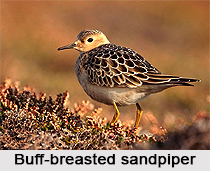 Buff-Breasted Sandpiper is an Indian bird and it has the scientific name "Tryngites subruficollis".
Buff-Breasted Sandpiper is an Indian bird and it has the scientific name "Tryngites subruficollis".
Family of Buff-Breasted Sandpiper
Buff-Breasted Sandpiper is a calidrid sandpiper and currently considered to be the only member of the genus Tryngites. Indeed, it probably belongs to the genus Calidris itself, or more precisely with the small species thereof that should be split into a distinct genus. Depending on whether this would include the curlew sandpiper or not, the name Erolia would or would not, respectively, apply.
Colour of Buff-Breasted Sandpiper
Buff-Breasted Sandpiper is brown above, and has a buff face and underparts in all plumages.
Gender of Buff-Breasted Sandpiper
Buff-Breasted Sandpiper has a short bill and yellow legs. Males are larger than females. Juveniles resemble the adults, but may be paler on the rear under parts.
Breeding of Buff-Breasted Sandpiper
Buff-Breasted Sandpiper breeds in the open arctic tundra of North America and is a very long-distance migrant, spending the non-breeding season mainly in South America, especially Argentina.
Migration of Buff-Breasted Sandpiper
Buff-Breasted Sandpiper migrates mainly through central North America, and is uncommon on the coasts. It occurs as a regular wanderer to Western Europe, and is not classed as rare in Great Britain or Ireland, where small flocks have occurred. Only the pectoral sandpiper is a more common American shorebird visitor to Europe.
Nests of Buff-Breasted Sandpiper
Buff-Breasted Sandpiper nests on the ground, laying four eggs. The male has a display which includes raising the wings to display the white undersides, which is also given on migration, sometimes when no other buff-breasted sandpipers are present. Outside the breeding season, this bird is normally found on short-grass habitats such as airfields or golf-courses, rather than near water.
Feeding of Buff-Breasted Sandpiper
Buff-Breasted Sandpiper picks up food by sight, mainly eating insects and other invertebrates. They are often very tame. Buff-breasted sandpipers are suspected to have hybridized with the white-rumped or Baird`s sandpiper.
Behaviour of Buff-Breasted Sandpiper
Buff-Breasted Sandpiper has been sighted in South Asia on at least three occasions. It is believed that instead of going to Argentina, this bird might have been wind-blown from the Great Plains Flyway of North America and landed up in South Asia. In 2011, November this species was sighted near Kannur, Kerala in South India. Buff-Breasted Sandpiper has also been recorded from Australia on at least eight occasions.



















